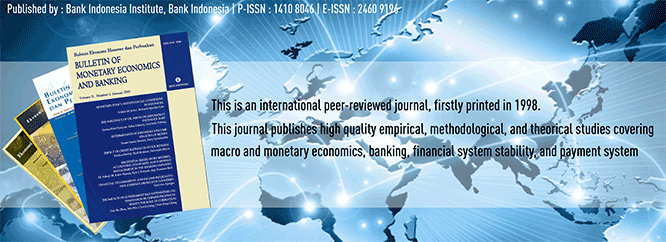
Document Type
Article
Abstract
Monetary policy may employ interest rate or money supply to derive the assigned national inflatio target. In this manner, most studies investigate monetary policy effectiveness using national data. However, based n the idea that inflation is a regional phenomenon, the application of provincial data is more appropriate in explaining the relationship between monetary instrument and inflation. This study elaborates the impact of changes in provincial money supply, BI Rate (interest rates of central bank), and PUAB (money market interest rates) to regional inflation in Hybrid New Keynesian Phillips Curve (HNKPC) framework. This study employs Generalized Method of Moments (GMM) techniques on panel data of 32 provinces from 2005-III to 2013-III. The data is classified into 4 groups, which are Java-Bali (W1), Sumatera (W2), Kalimantan-Sulawesi (W3), and Papua-Maluku-Nusa Tenggara (W4). The estimation result shows that each monetary instrument has diverging effectiveness in different regions. Provincial monetary aggregate is only effective in Sumatera, while BI Rate can manage inflation in Sumatera and Kalimantan-Sulawesi. PUAB, on the other hand, is significantly affecting inflation in almost all Indonesian regions, except Kalimantan- Sulawesi. We conclude that interest rate (BI rate and PUAB) is a more appropriate instrument, compared to provincial monetary aggregate, to control provincial inflation in Indonesia.
Recommended Citation
Utama, Chandra; Wijaya, Miryam B.L.; and Lim, Charvin
(2017)
"THE ROLE OF INTEREST RATES AND PROVINCIAL MONETARY AGGREGATE IN MAINTAINING INFLATION IN INDONESIA,"
Bulletin of Monetary Economics and Banking: Vol. 19:
No.
3, Article 3.
DOI: https://doi.org/10.21098/bemp.v19i3.666
Available at:
https://bulletin.bmeb-bi.org/bmeb/vol19/iss3/3
First Page
267
Last Page
286
Creative Commons License

This work is licensed under a Creative Commons Attribution-NonCommercial 4.0 International License
Country
Indonesia
Affiliation
Parahyangan Catholic University







